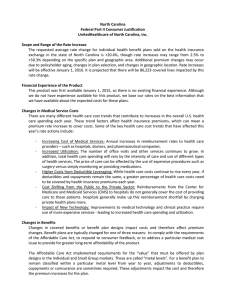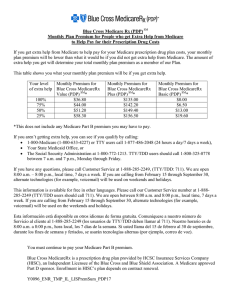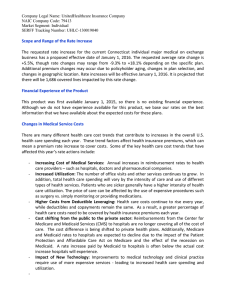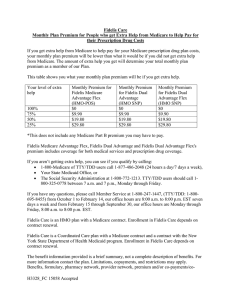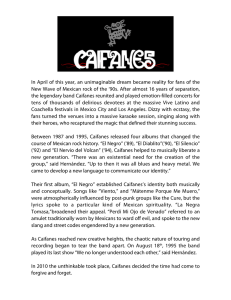implicit loadings in life insurance ratemaking and coherent risk
Anuncio
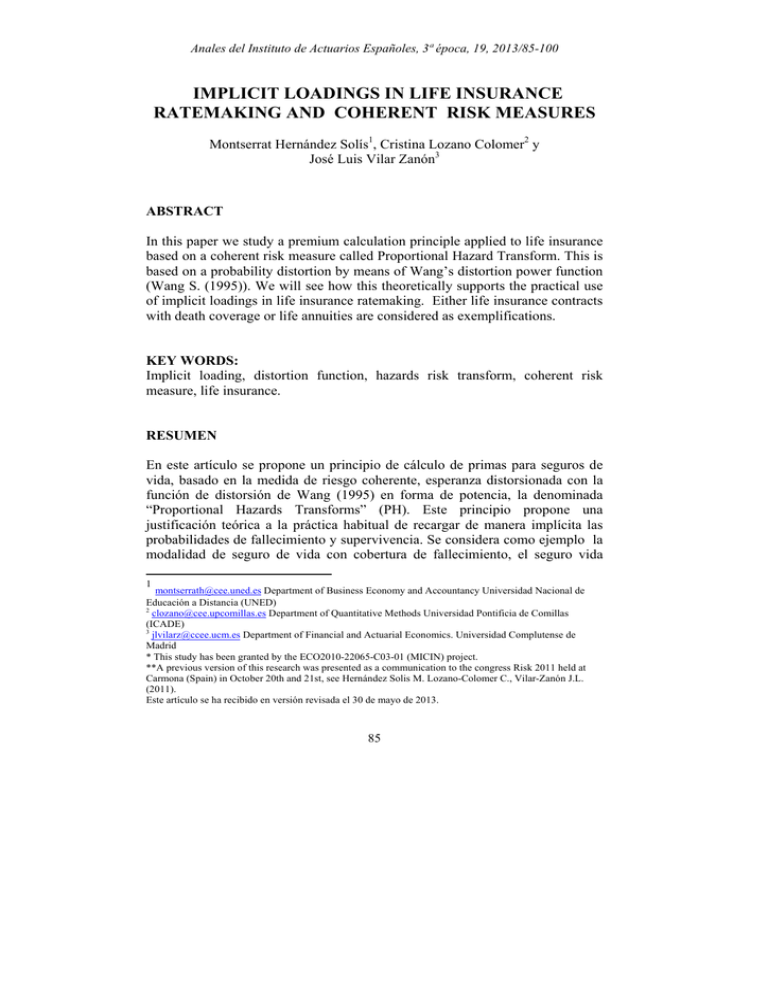
Anales del Instituto de Actuarios Españoles, 3ª época, 19, 2013/85-100
IMPLICIT LOADINGS IN LIFE INSURANCE
RATEMAKING AND COHERENT RISK MEASURES
Montserrat Hernández Solís1, Cristina Lozano Colomer2 y
José Luis Vilar Zanón3
ABSTRACT
In this paper we study a premium calculation principle applied to life insurance
based on a coherent risk measure called Proportional Hazard Transform. This is
based on a probability distortion by means of Wang’s distortion power function
(Wang S. (1995)). We will see how this theoretically supports the practical use
of implicit loadings in life insurance ratemaking. Either life insurance contracts
with death coverage or life annuities are considered as exemplifications.
KEY WORDS:
Implicit loading, distortion function, hazards risk transform, coherent risk
measure, life insurance.
RESUMEN
En este artículo se propone un principio de cálculo de primas para seguros de
vida, basado en la medida de riesgo coherente, esperanza distorsionada con la
función de distorsión de Wang (1995) en forma de potencia, la denominada
“Proportional Hazards Transforms” (PH). Este principio propone una
justificación teórica a la práctica habitual de recargar de manera implícita las
probabilidades de fallecimiento y supervivencia. Se considera como ejemplo la
modalidad de seguro de vida con cobertura de fallecimiento, el seguro vida
1
montserrath@cee.uned.es Department of Business Economy and Accountancy Universidad Nacional de
Educación a Distancia (UNED)
2
clozano@cee.upcomillas.es Department of Quantitative Methods Universidad Pontificia de Comillas
(ICADE)
3
jlvilarz@ccee.ucm.es Department of Financial and Actuarial Economics. Universidad Complutense de
Madrid
* This study has been granted by the ECO2010-22065-C03-01 (MICIN) project.
**A previous version of this research was presented as a communication to the congress Risk 2011 held at
Carmona (Spain) in October 20th and 21st, see Hernández Solis M. Lozano-Colomer C., Vilar-Zanón J.L.
(2011).
Este artículo se ha recibido en versión revisada el 30 de mayo de 2013.
85
Implicit loadings in life insurance ratemaking and coherent… - Anales 2013/81-100
entera, y a la modalidad de seguro de vida con cobertura de supervivencia, el
seguro de rentas vitalicio.
PALABRAS CLAVE: Recargo implícito, función de distorsión, transformada
del tanto instantáneo, medida de riesgo coherente, seguro de vida.
1. INTRODUCTION
In order to protect themselves against the risk arising from fluctuations in
claims severities, insurance companies calculate security loadings. These may
be explicitly calculated or implicitly assumed in the ratemaking, the later being
the most common practice in life insurance.
When considering life insurance with death coverage, an adverse claim severity
consists in lives lasting shorter than expected. Thus a common practice when
calculating premiums is adding an implicit loading either defined as a safety
margin conceived as a percentage of the death probabilities qx , or using a
mortality table with higher probabilities than those of the human group taken
into account. The last is equivalent to consider a higher mortality instantaneous
rate (for instance considering outdated mortality tables).
The opposite situation is found in life insurance with survival benefits, where an
adverse claim severity occurs when life last longer than expected. In this case
the insurance company can implicitly load the premium using mortality tables
with lower death probabilities that decreases the instantaneous mortality rate.
Wang (1995) proposes a loaded premium calculation for non-life insurance
using distorted probabilities. It is called proportional hazard transform (PH),
and is in fact a coherent risk measure (Artzner, P. (1999)) with a distortion
function of the form g(u) = u1/ρ , where it is shown that the necessary condition
for such a risk measure to be coherent is ρ ≥ 1 .
This article applies this result in the two following ways.
The more immediate one consists in applying the result from Wang (1996) to
the case of survival insurance (i.e. life annuity insurance) showing that the
common practice of implicitly loading the premium considering a lower
instantaneous mortality rate can be considered in fact as a proper coherent risk
86
Montserrat Hernández, Cristina Lozano y José Luis Vilar – Anales 2013/85-100
measure. This is worked out expressing the net premium with respect to the
survival function, then applying the proportional hazard transform (which
stands in the case ρ ≥ 1 and is coherent) and checking that this corresponds to a
new instantaneous mortality rate proportional to the former by a factor of 1/ρ.
This step is in fact done in a second stage (see section 5).
But the first stage and main way of the study (see section 4), is the case of death
coverage products (i.e. whole life insurance contracts) which is in fact out of
Wang’s result. This is motivated by the fact that considering an implicit loading
would be equivalent to the calculation of a net premium corresponding to a
higher instantaneous mortality rate. If we tried then to follow the same scheme
as in the survival products case, we would find the obstacle that trying to
express the net premium with respect to the survival function would no longer
reward us with an expression that could be considered as a proportional hazard
transform. A careful inspection of the expression obtained through this method
will tell us that it is in fact a function of the proportional hazard transform this
time with an exponent ρ ∈ (0,1) . Our goal consists in showing that this function
still is a coherent risk measure.
Therefore this article seeks to justify a standard practice in life insurance
showing that it may be viewed as the application of a coherent risk
measure.
Section 2 is recalls some basic concepts on risk measures and premium
calculation principles, while the proportional hazard transform is
introduced along section 3. We will consider whole life insurance and life
annuity contracts as exemplifications.
2. RISK MEASURES
PRINCIPLES
BASED
ON
PREMIUM
CALCULATION
Premium calculation principles can be considered candidates for being risk
measures. Although there is a consensus about how to calculate the net
premium, there are many ways to aggregate the loading in order to obtain a
premium reflecting the risk accepted by the insurer. On the other hand, risk
measures are very interesting because they allow to quantify the way the
premium compensates the insurer for the risk associated to the loss.
87
Implicit loadings in life insurance ratemaking and coherent… - Anales 2013/81-100
Before introducing a premium based on a risk measure, let us remember a
formal definition of the later and the properties a risk measure must fulfill to be
coherent (Artzner, P. (1999)).
Definition 1. Given a loss, modeled by means of a non-negative random
variable X, a risk measure H(X) is a functional H : X → . Artzner (1999)
suggests the following four axioms for a risk measure to be considered
coherent:
I. Translation Invariance. For any random variable X and any nonnegative constant b,
H(X + b) = H(X) + b.
This axiom states that if the loss X were increased by a fixed
amount b, the risk would increase by the same amount.
II. Subadditivity. For all pairs of random variables X and Y,
H(X + Y) ≤ H(X) + H(Y).
This axiom states that an insurance company cannot reduce its risk
by dividing its business in smaller blocks.
III. Positive homogeneity. For any random variable X and any nonnegative constant a>0
H(aX) = a H(X).
This axiom states that a change in the monetary unit does not
change the risk measure.
IV. Monotonicity. For every pair of random variables X and Y, such
that Pr (X ≤ Y) = 1 then
H(X) ≤ H(Y).
This axiom states that if one risk loss is not greater than another for
all states of nature, the risk measure of the former cannot be greater
than the risk measure of the later.
For instance it is very well known that the risk measure based on the expected
value principle is
H(X) = (1 + α)μ X (α ≥ 0),
88
Montserrat Hernández, Cristina Lozano y José Luis Vilar – Anales 2013/85-100
where α is the risk loading and μ X stand for the mean of the loss X.
When α = 0 , the risk measure is called pure or net premium. Other
important premium principles are for instance, the variance and the
standard deviation:
H(X) = μ X + β σ X2
β≥0
H(X) = μ X + γ σ X
γ ≥ 0.
It is known (Yiu-Kuen Tse (2009) p.118) that these premium calculation
principles are not coherent risk measures since the expected value principle
does not verify the axiom of invariance under translations, and the standard
deviation principle does not verify the monotony axiom. On the other hand, the
net premium principle ( α = 0 ) is a coherent risk measure.
3-THE PROPORTIONAL TRANSFORM OF THE INSTANTANEOUS
RATE AS A RISK MEASURE.
Consider a risk X ≥ 0 with distribution function and survival function:
F(x) = Pr ( X ≤ x )
S(x) = 1 − F(x).
(1)
The net premium based on the expected value risk measure expressed by means
of the survival function is:
∞
∞
0
0
E ( X ) = ∫ x dF(x) = ∫ S(x)dx.
We must now define a loaded premium likely to be better adjusted to the risk
and based on the distortion function (Wang(1995)):
Definition 2: Given a risk X with survival function S(x), and a non-decreasing
function g : [0,1] → [0,1] with g(0) = 0, g(1) = 1 called the distortion
function, the risk premium adjusted to the distorted probability risk measure is:
∞
E g ( X ) = ∫ g ( S(x) ) dx.
0
89
(2)
Implicit loadings in life insurance ratemaking and coherent… - Anales 2013/81-100
Supposing that g and S have first derivatives, the distortion function verifies the
following properties (Wang 1996):
1. g(S(x)) is non-decreasing .
2. 0≤ g(S(x)) ≤1 for any x ∈[0, +∞).
3. If g and S are continuous functions, g(S(x)) can be considered as the
survival function of another random variable Y with density function
given by
d g(S(x))
f Y (x) = −
= − g '(S(x))S'(x) = g '(S(x))f (x).
dx
Therefore g’(S(x)) is a weighting function of the density function f(x).
Moreover, if g is concave then
d g ′[S(x)]
= g ′′[S(x)]S′(x) ≥ 0.
dx
Therefore the distortion function allows us to define a new random variable Y,
since g(S(x)) has the properties of a survival function.
We now consider a power function as a special case of distortion (Yiu-Kuen
Tse. (2009), p.129). This case is well known in non-life insurance because it
satisfies the properties of a coherent risk measure. It is also well known that
considering a power of the survival function results in a proportional
instantaneous mortality rate. As we are going to see soon, this has an interesting
interpretation in life insurance.
Definition 3: A proportional transform of the instantaneous rate is a Wang
measure with the following distortion function:
g(u) = u1/ρ , ρ > 0.
(3)
In this case a new random variable Y is defined from the original X, with
survival function and premium adjusted to the risk given by:
SY (x) = ( S(x) )
1/ρ
, ρ >0
+∞
Πρ ( X ) = E ( Y ) = ∫ ( S(x) )1/ρ dx.
0
We can deduce from definition 3 the following consequences:
90
(4)
Montserrat Hernández, Cristina Lozano y José Luis Vilar – Anales 2013/85-100
1. E(Y) is an increasing function with respect to ρ. The higher is ρ, the
higher will be the risk-adjusted premium. Thus ρ can be considered as a risk
aversion parameter (see Yiu-Kuen Tse (2009) p.129).
2. The instantaneous rates of the random variables X and Y are
proportional.
Recalling that:
1/ρ
SY (t) = ( S(t) )
1/ρ
⎛
⎛ t
⎞⎞
= ⎜ exp ⎜ − ∫ μx (u) du ⎟ ⎟
⎜
⎟⎟
⎜
⎝ 0
⎠⎠
⎝
⎛ t1
⎞
= exp ⎜ − ∫ μx (u) du ⎟ .
⎜ ρ
⎟
⎝ 0
⎠
We can write:
μ Y (t) =
1
μ x (t), ρ > 0 , t ≥ 0.
ρ
(5)
Therefore the X and Y instantaneous rates of mortality are proportional. The
new random variable Y is called the proportional instantaneous rate transform
of X with parameter ρ (Wang (1996)).
This transform only requires that ρ > 0, though in the context of general
insurance ρ ≥ 1 is considered in order to give more weight to the tail of the risk
distribution.
Assuming that
S Y (x) = ( S(x) )
1/ρ
, ρ ≥ 1,
the Y survival function decreases slower than the X one, with greater
probabilities for larger values of the variable, so the risk-adjusted premium or
the loaded premium verifies Πρ (Y) = E ( Y ) ≥ E ( X ) , the difference being the
security loading.
As indicated in (Wang (1995)), the risk-adjusted premium reflects the risk of
the original loss, and the decision maker’s risk aversion is adjusted by means of
the parameter values ρ.
As shown in (Wang (1995)), for ρ ≥ 1 the distorted risk probabilities are a
coherent risk measure. In fact, the constraint ρ ≥ 1 is mainly necessary for the
measure to fulfill the subadditivity property, the other axioms requiring only ρ
>0.
91
Implicit loadings in life insurance ratemaking and coherent… - Anales 2013/81-100
4.
NET PREMIUM CALCULATION
INSURANCE CONTRACT.
FOR
A
WHOLE
LIFE
Whole life insurance is a death coverage insurance such that the insurer
undertakes to pay the guaranteed policy benefit to the beneficiaries, whatever
the moment of the insured’s death could be (see for example Bowers et al.
(1997) p.94). It is an insurance policy with a fixed amount and random
maturity.
Let us consider a whole life insurance contract for an individual (x) in
continuous time, with one monetary unit as the insured capital. In this case the
risk can be modeled by the random variable T(x), residual life or time remaining
until the insured’s death. The following assumptions hold:
1. At the time of death a monetary unit is paid.
2.
i is the technical rate of interest.
3. A newborn’s death time is a continuous random variable X, with
survival function S(x). Then the random variable T(x) has a distribution
function Gx(t) and a survival function Sx(t) whose expressions
depending on S(x) are given by (Bowers et al (1997) p.52) :
S(x) − S(x + t)
S(x + t)
= 1−
S(x)
S(x)
S(x + t)
Sx (t) = 1 − G x (t) =
.
S(x)
G x (t) =
(6)
−1
4. Defining v = (1 + i ) , the loss associated to the policy is then
defined by means of the random variable:
Z=v
T( x )
(7)
Applying the actuarial equivalence principle, the following expression is
obtained (Bowers et al. (1997) p.95) for the pure premium:
+∞
Π ( Z) = ∫
v t dG x (t)
0
92
(8)
Montserrat Hernández, Cristina Lozano y José Luis Vilar – Anales 2013/85-100
In order to adapt the actuarial equivalence principle to premium calculation
based on the distortion function, this is now expressed depending on Sx(t).
Π ( Z) =
+∞
∫
0
+∞
vt dG x (t) = − ∫ vt dSx (t) .
(9)
0
Changing the variable to v t = z :
1
Π ( Z ) = ∫ z dSx ⎛⎜
ln z ⎞
⎟ .
⎝ lnv ⎠
0
Integrating by parts:
z=u
dz = du
⎛ Ln z ⎞
⎛ Ln z ⎞
dSx ⎜
⎟ = dv v = Sx ⎜
⎟
⎝ Ln v ⎠
⎝ Ln v ⎠
1
1
1
⎛
⎛ Ln z ⎞ ⎞ 1 ⎛ Ln z ⎞
⎛ Ln z ⎞
⎛ Ln z ⎞
−
=
−
=
−
Π ( Z ) = ⎜ z Sx ⎜
S
dz
1
S
0
S
dz
1
Sx ⎜
(
)
(
)
⎟⎟ ∫ x ⎜
⎟
⎟
⎟ dz
x
x⎜
∫
∫
⎝ Ln v ⎠ ⎠0 0 ⎝ Ln v ⎠
⎝ Ln v ⎠
⎝ Lnv ⎠
0
0
⎝
We finally obtain an expression for the pure premium based on Sx (t)
1
⎛ ln z ⎞
Π ( Z ) = 1 − ∫ Sx ⎜
⎟ dz .
⎝ ln v ⎠
0
(10)
Now a loaded premium is obtained substituting the survival function into the
power distortion function. In (11) we find its expression, where the subscript ρ
emphasizes the dependency of the premium on the previous choice of the power
function:
1/ρ
1
⎛ ⎛ ln z ⎞ ⎞
Π ρ ( Z ) = 1 − ∫ ⎜ Sx ⎜
⎟⎟
⎝ ln v ⎠ ⎠
0⎝
dz.
(11)
It is clear that the exponent should be ρ ≤ 1 for the loaded premium to be greater
than the pure premium.
93
Implicit loadings in life insurance ratemaking and coherent… - Anales 2013/81-100
We are now going to show how this loaded premium can be deduced
considering the proportional transformation of the instantaneous rate, and also
that it is a coherent measure of risk (remember that in this case ρ ≤ 1 ).
Theorem 1. The loaded premium (11) equals the pure premium of another
random variable with the same survival law model, but with instantaneous
mortality rate proportional to the one of the random variable X, by a
proportionality factor of 1/ρ.
Proof:
In fact, if we integrate by parts expression (11) and writing r =
⎛ ⎛ ln z ⎞ ⎞
u = ⎜ Sx ⎜
⎟⎟
⎝ ⎝ ln v ⎠ ⎠
dv = dz
r
1
⎛ ln z ⎞ ⎛ ⎛ ln z ⎞ ⎞
du = r
S′x ⎜
⎟ ⎜ Sx ⎜
⎟⎟
z log v ⎝ ln v ⎠ ⎝ ⎝ ln v ⎠ ⎠
1
:
ρ
r −1
dz
v=z
r
1
⎛ ⎛ ln z ⎞ ⎞
Π ρ ( Z ) = 1 − ∫ ⎜ Sx ⎜
⎟ ⎟ dz =
⎝ ln v ⎠ ⎠
0⎝
⎛ ⎛ ln z ⎞ ⎞
= 1 − z ⎜ Sx ⎜
⎟⎟
⎝ ⎝ ln v ⎠ ⎠
r1
0
1
1
⎛ ln z ⎞ ⎛ ⎛ ln z ⎞ ⎞
+ ∫zr
S′x ⎜
⎟ ⎜ Sx ⎜
⎟⎟
z log v ⎝ ln v ⎠ ⎝ ⎝ ln v ⎠ ⎠
0
r −1
r
1
⎛ ⎛ ln z ⎞ ⎞
dz = ∫ z d ⎜ Sx ⎜
⎟⎟ .
⎝ ⎝ ln v ⎠ ⎠
0
Now changing variable z = v t :
∞
∞
Πρ ( Z ) = − ∫ v t d ( Sx (t) ) = − ∫ v t d ( Sx (t) )
0
r
1/ρ
.
(12)
0
Comparing (12) with (9), we see that it corresponds to the pure premium of an
insurance of the same kind, though for a new random variable Y with survival
function SY (t) = ( Sx (t) )
(5):
1/ρ
. Therefore we are in the same situation described in
1
μ Y (t) = μ X (t),
ρ
(13)
where μ X (t) is now the instantaneous rate of the original variable X. (Q.E.D.)
94
Montserrat Hernández, Cristina Lozano y José Luis Vilar – Anales 2013/85-100
Thus we can conclude that for any survival law the loaded premium coincides
with the pure premium that would be obtained for that law, though with a
1
proportional rate by a factor ≥ 1 . Therefore the new instantaneous rate is
ρ
higher and this represents an adverse claim experience for the insurer.
Going now into de first step mentioned during the introduction, the following
theorem shows that the subadditivity property is also verified by the premium
defined in (10):
Theorem 2: For every pair of non-negative random variables U and V, and the
risk measure given by:
1
Hρ (U) = 1 − ∫ ( SU ( z ) )
1/ρ
dz,
0 < ρ ≤ 1 , z = vt , v =
0
1
,
1+ i
the subadditivity property holds:
Hρ (U + V) ≤ Hρ (U) + Hρ (V).
(14)
We will proceed quite similarly as is done in Wang (1996). Let us firstly show a
previous lemma which plays a similar role as the one that can be found in Wang
(1996).
Lemma 1. If 0 < a < b and ρ ≤ 1 then ∀x ≥ 0 the following holds:
( − ( x + b ) ) − ( − ( x + a ) ) ≤ ( − b ) − ( −a ) .
1/ρ
1/ρ
1/ρ
1/ρ
Proof:
Calling
1⎞ ⎛
1⎞
⎛
ρ
ρ
g(x) = ⎜ −(b + x) ⎟ − ⎜ −(a + x) ⎟
⎜
⎟ ⎜
⎟
⎝
⎠ ⎝
⎠
1
1 ⎞
⎛
−1
−1
1⎜
ρ
ρ
− (b + x) ⎟ < 0 because
g ′(x) = (a + x)
⎟
ρ⎜
⎝
⎠
95
1
− 1 > 0, and a + x < b + x.
ρ
Implicit loadings in life insurance ratemaking and coherent… - Anales 2013/81-100
Knowing that g(x) is a decreasing function, it will get its maximum value in
x=0, in which case we will have
1⎞ ⎛
1⎞ ⎛
1⎞ ⎛
1⎞
⎛
⎜ −(b + x) ρ ⎟ − ⎜ − (a + x) ρ ⎟ < ⎜ − b ρ ⎟ − ⎜ −a ρ ⎟ . (Q.E.D.)
⎜
⎟ ⎜
⎟ ⎜
⎟ ⎜
⎟
⎝
⎠ ⎝
⎠ ⎝
⎠ ⎝
⎠
Proof of Theorem 2:
The proof uses the method of complete or strong induction.
Firstly the result is shown to be true for a random variables V and U, this last
being discrete such that U ∈{0,1,K , n}. Then applying the translation
invariance and the positive homogeneity properties, it will also be proved for
any discrete random variable U ∈{kh,K,(n + k)h}, (h>0), with h > 0. Finally,
since any random variable can be arbitrarily closely approximated by a discrete
random variable U with adequate h, k, the result will have been proven for any
random variable.
Looking to (14) and reasoning by means of complete induction:
- If n=0 then U=0 and the result is trivial
- Assuming (14) to be true in the n-th case, let us examine the (n+1) case:
Given (U, V) with U ∈ {0,1......n + 1} define (U*, V*) as ( U, V U > 0 ) .
Assuming U* ∈{1,K, n + 1} the induction hypothesis states that:
Hρ (U * + V*) ≤ Hρ (U*) + Hρ (V*).
Writing ω0 = Pr ( U = 0 ) , S V 0 (t) = Pr ( V > t U = 0) , for any t > 0
Pr (U > t) = Pr ( U* > t U > 0 ) Pr ( U > 0 ) ,
This is the same than:
SU (t) = (1 − ω0 ) SU* (t).
On the other hand
96
Montserrat Hernández, Cristina Lozano y José Luis Vilar – Anales 2013/85-100
SV (t) = Pr ( V > t ) =
= Pr ( V > t U = 0 ) Pr ( U = 0 ) + Pr ( V > t U > 0 ) Pr ( U > 0 ) =
= SV 0 (t) ω0 + SV* (t) (1 − ω0 ) .
Also:
SU + V (t) = Pr ( U + V > t ) =
= Pr ( U + V > t U = 0 ) Pr ( U = 0 ) + Pr ( U + V > t U > 0 ) Pr ( U > 0 ) =
= ω0 SV 0 ( t ) + (1 − ω0 ) SU*+ V* (t).
Now according to Lemma 1:
− SU + V (t)1/ρ − (− SU (t)1/ρ ) − (− SV (t)1/ρ ) =
(
= − ω0 SV 0 + (1 − ω0 ) SU*+ V* (t)
≤ (1 − ω0 )
1/ ρ
) − ( − ((1 − ω )S
1/ ρ
0
U* (t)
)
1/ρ
( −SU*+V* (t)1/ρ − (− SU* (t)1/ρ ) − (− SV* (t)1/ρ ) ) ≤
) − ⎛⎜⎝ − (S
V 0 (t)
ω0 + SV* (t) (1 − ω0 )
≤ −SU*+ V* (t)1/ρ − (−SU* (t)1/ρ ) − (−SV* (t)1/ρ ).
Next we reconstruct the corresponding expressions by adding one to each integral in
both sides (the reader will check that in fact this changes nothing). Changing the
ln z
, and integrating with respect to z we finally obtain:
variable to v t = z ⇔ t =
ln v
1
1 − ∫ SU + V (
0
1
1
⎛
ln z 1/ρ
ln z 1/ρ
ln z 1/ρ ⎞
) dz − ⎜ 1 − ∫ S U (
) dz + 1 − ∫ SV (
) dz ⎟ ≤
⎜
⎟
ln v
ln
v
ln
v
0
0
⎝
⎠
1
ln z 1/ρ
) dz −
≤ 1 − ∫ S U*+ V* (
ln v
0
1
1
⎛
ln z 1/ρ
ln z 1/ρ ⎞
⎜ 1 − ∫ S U* (
) dz + 1 − ∫ S V* (
) dz ⎟ .
⎜
⎟
ln v
ln v
0
0
⎝
⎠
(15)
The expression (14) can be written as
(
(
)
)
Hρ (U + V) − Hρ (U) + Hρ (V) ≤ Hρ (U* + V* ) − Hρ (U* ) + Hρ (V* ) ≤ 0 .
The last inequality is true by virtue of the induction hypothesis, so we conclude
that the subadditivity axiom is also fulfilled by U and V. Therefore this
premium calculation principle is a coherent risk measure. (Q.E.D)
97
)
1/ρ ⎞
⎟≤
⎠
Implicit loadings in life insurance ratemaking and coherent… - Anales 2013/81-100
Observation: Theorem 2 shows that the premium calculation principle for a
T x
whole life insurance contract with loss Z = v ( )
1/ρ
1
⎛ ⎛ ln z ⎞ ⎞
Hρ (Z) = 1 − ∫ ⎜ Sx ⎜
⎟⎟
⎝ ln v ⎠ ⎠
0⎝
dz,
0 < ρ ≤ 1 , z = vt , v =
1
,
1+ i
is a coherent risk measure. It cannot be considered as a generalization of
Wang’s result, but it theoretically supports the practice of modifying the
instantaneous mortality rate in the case of death coverage products.
5. CALCULATION OF THE SINGLE PREMIUM FOR A LIFE
INSURANCE WITH SURVIVOR’S COVERAGE (LIFE
ANNUITY INSURANCE)
A continuous-time life annuity insurance (Bowers et al. (1997) p.134) is
characterized by annuities payable continuously. Payments are made by the
insurance company to an insured (x) as long as he is alive. In exchange the
insured must pay the amount of the premiums to the company, either
periodically or in the form of a single premium. In this case the risk can be
modeled by the random variable T(x), residual life or time remaining until the
insured’s death. The following assumptions hold:
1. We have annuities payable continuously at the rate of 1m.u. per year
(Bowers et al. (1997) p.134) until death.
2.
i is the technical rate of interest.
3. Then the random variable T(x) has a distribution function Gx(t) and a
survival function Sx(t) whose expressions depending on S(x) are given
in (6).
−1
4. Defining v = (1 + i )
the loss associated to the policy is then
defined by means of the random variable the present value of
payments Z = aT( x ) , where:
t
at = ∫ v u du =
0
98
1
(v t − 1)
ln v
Montserrat Hernández, Cristina Lozano y José Luis Vilar – Anales 2013/85-100
Applying the actuarial equivalence principle to get the pure premium (Bowers
et al. (1997) p.135) we find:
+∞
Π(Z) = E(Z) =
∫v
t
t p x dt ,
0
where v =
1
< 1 , and t p x = Sx (t) .
1+ i
Changing the variable v t = z we obtain an expression for the pure prime based
on Sx (t)
+∞
Π(Z) =
∫
v t Sx (t)dt = −
0
1
⎛ lnz ⎞
1
Sx ⎜
⎟ dz.
∫
ln v 0
⎝ ln v ⎠
(16)
The loaded premium using the distortion function “proportional transformation
of the hazard function” given by (3) has the following form:
1
Π ρ (Z) = −
ln v
1
∫
0
1
⎛ ln z ⎞ ρ
Sx ⎜
⎟ dz
⎝ ln v ⎠
with
1
≤ 1 , Π ρ ≥ Π ⇒ ρ ≥ 1.
ρ
(17)
Now for the loaded premium to be greater or equal than the pure premium, the
exponent must be less or equal than 1, so ρ ≥1. Therefore these distorted
probabilities satisfy the properties of a coherent risk measure (Wang (1996)).
ln z
given in (17) the distorted survival function is greater
ln v
than the initial survival function, which means that the insured is deemed to
have a lower risk of death. In this way, an annuity loss rate increases if the
insured lives longer than expected. Thus the distortion function gives more
weight to the tail of the residual time variable, resulting in a loaded premium.
For each value of t =
Theorem 3.
The loaded premium (17) coincides with the pure premium of another random
variable, with the same survival model law but an instantaneous mortality rate
99
Implicit loadings in life insurance ratemaking and coherent… - Anales 2013/81-100
proportional to the instantaneous rate of variable X, with a proportionality factor
1
equal to .
ρ
Proof of Theorem 3:
t
In fact, if in expression (17) we introduce the change of variable z = v , we
obtain:
z = 0, t = ∞
z = 1, t = 0
dz = v t ln v dt
∞
0
Π ρ (Z) = −
1
(Sx (t) )1/ρ v t ln v dt = ∫ v t (Sx (t) )1/ρ dt.
ln v ∞∫
0
1
ρ
Calling S Y (t) = (S x (t)) the expression of the instantaneous rate of variable Y
equals (5):
1
μ Y (t) = μ X (t).
ρ
Thus the instantaneous rate of the new variable is proportional to the original
variable. (Q.E.D.)
REFERENCES:
Artzner, P. (1999): Application of coherent risk measures to capital requirements in
insurance. North American Actuarial Journal. Vol. 3, N.2, pp.11-25.
Bowers, N.L. et al. (1997): Actuarial Mathematics. Society of Actuaries.
Denuit M., Dahene J., Goovaerts M., Kaas R. (2005): Actuarial Theory for dependent
risks. John Wiley & Sons Ltd.
Hernández Solis M. Lozano-Colomer C., Vilar-Zanón J.L. (2011): Tarificación en
Seguros de Vida con la medida de riesgo esperanza distorsionada, Investigaciones en
Seguros y Gestión del Riesgo: Riesgo 2011, Cuadernos de la Fundación 171, pp. 93108.
Rotar, V. (2006): Actuarial Models. Chapman and Hall
Wang, S. (1995): Insurance pricing and increased limits ratemaking by proportional
hazards transforms. Insurance, Mathematics and Economic, Vol.17, pp. 42-54.
Wang, S. (1996): Premium calculation by transforming the layer premium density.
Astin Bulletin, Vol.26, pp.71-92.
Wang, S., Young, V. Panjer, H. (1997): Axiomatic characterization of insurance prices.
Insurance Mathematics and Economics, Vol. 21, pp.173-183.
Yiu-Kuen Tse (2009): Nonlife Actuarial Models. Theory, methods and evaluation.
Cambridge University Press.
100
